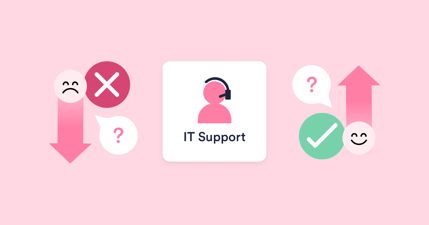IT service desks have long held customer satisfaction (CSAT) up as the independent view of their performance. After all, it’s what end-users think of IT – with CSAT targets and scores used to show end-user happiness with IT support capabilities and to identify improvements where needed.
However, if CSAT scores were an accurate view of end-user perceptions of IT support performance, there wouldn’t be so many instances of IT horror stories or end-user reluctance to contact the IT service desk. For example, Forrester Research data from its “The State Of The Service Desk, 2022” report found that while 67% of the survey respondants who contact the service desk were satisfied with their IT service desk:
- 62% of 7,048 respondents stated that “I avoid my service desk”
- 58% said, “I am living with ongoing problems that the service desk can’t fix.”
So, while CSAT scores might show end-user satisfaction, there can still be underlying IT support issues that are never highlighted or addressed through CSAT feedback or other metrics. The potential reasons for this are addressed next.
The common issues with CSAT questionnaires and scores
CSAT is one of the most common IT service desk metrics. This is evidenced in HDI’s “The State of Technical Support in 2023” report, which found the top five IT support metrics used in North America to be:
- Average time to respond (non-phone channels)
- Customer satisfaction
- Average number of tickets resolved per staff member
- Staff satisfaction
- Cost per ticket (desktop support).
It makes sense because it ideally offers some balance, along with staff satisfaction, to what is otherwise a portfolio of operationally focused performance measures.
However, there are potential issues when an IT service desk uses CSAT questionnaires – for example:
- Feedback requests aren’t made in a timely manner
- Low response rates
- Response bias – with only the very happy and unhappy end-users providing feedback
- Questions often relate to IT support operations, not the outcomes
- Too many questions at the initial feedback stage create a barrier to survey completion
- There’s a lack of response and action related to the received feedback.
Additionally, post-contact CSAT questionnaires only go to employees who have used the IT service desk. As the earlier Forrester research shows, many end-users likely don’t contact the IT service desk when they have an issue.
Finally, CSAT scores are rarely as deeply connected to operational data points as HappySignals experience data. While both reflect how satisfied customers are, being able to drill down into the data allows an understanding of the feedback data in context.
CSAT data, like other IT metrics, doesn’t always surface the common employee issues
The shared CSAT issues are often the symptoms of different root causes, with these similar to other traditional IT metrics. One is that the metrics weren’t designed to measure experiences, instead focusing on operational efficiency more than outcomes. This means the common portfolio of IT support metrics can’t show what end-users think of IT performance, even the CSAT measure.
This omission is proved by experience data, such as the aggregated HappySignals customer data shared in the Global IT Experience Benchmark, where example experience-based insights show that:
- End-users are unhappier with corporate devices and enterprise applications than any other aspects of IT performance, scoring between +5 and +15 versus +80 for services. Employees lose a significant amount of productivity with these each month.
- While the most used IT support channel, the IT self-service portal offers the worst employee experience (Happiness is +74), and employees lose nearly two hours per ticket more than when using the phone channel.
- Two of the top three factors for negative employee experiences are “My ticket was not resolved” and “I had to explain my case several times.” Yet, it’s likely that CSAT questionnaires don’t ask about and highlight issues related to these factors.
- Some tickets result in far more lost time than others, with the headline statistic being that “80% of employees perceived lost time comes from only 13% of incident tickets.” If all the employees affected by the 13% of tickets accurately fed back their IT support experience via CSAT questionnaires, it’s unlikely that the CSAT target would be met.
- With every ticket reassignment, on average end-user happiness decreases by nearly 8 points, and 1 hour and 42 minutes of work time is lost. When a ticket is reassigned four times, an end-user loses 8 hours and 22 minutes, but this insight is likely lost when tickets are placed on hold by the IT service desk.
While these statistics might appear worrying, it’s important to appreciate that they are the average of HappySignals customers at different points in their experience improvement journeys. Still, the data is likely better than for organizations with no experience focus.
Your IT service desk is meeting its CSAT targets, but…
Is your IT support really meeting business needs?
Hopefully, this shared experience data and insights are eye-opening. Your IT service desk could be consistently hitting its CSAT target of 4 or even 4.5 out of 5, and other service-level targets, but still have these or similar issues. Because traditional IT support metrics focus on operational factors such as “how many” and “how fast” rather than how the IT service desk is helping or hindering employee productivity.
Experience data allows IT service desk teams to take a different perspective: experience- and outcome-focused. Allowing them to finally see what end-users really think of the IT support they receive.
If you want to learn more about how experience data will help your IT service desk to improve in line with end-user and business expectations, take a look at our Global IT Experience Benchmark Report.




